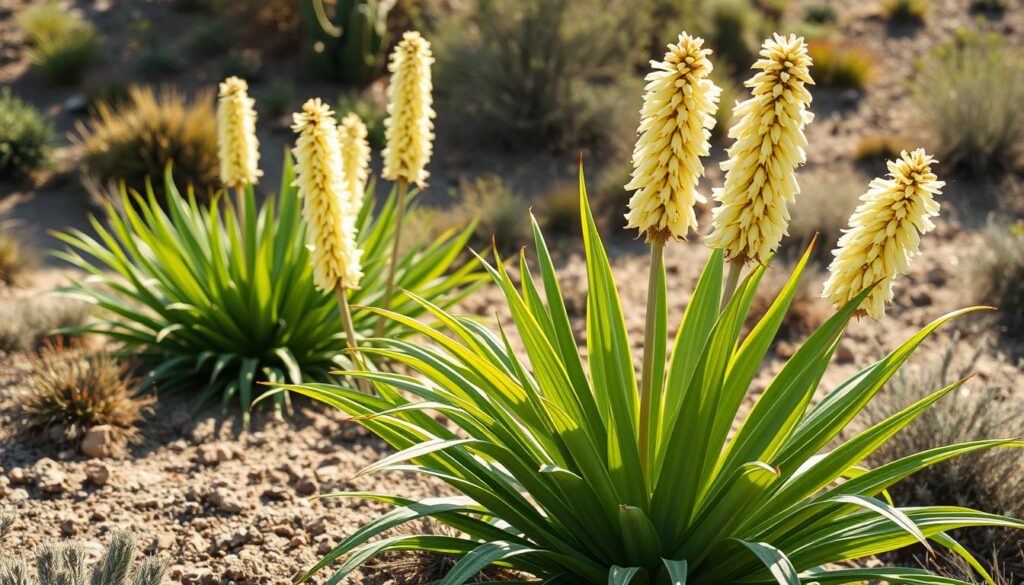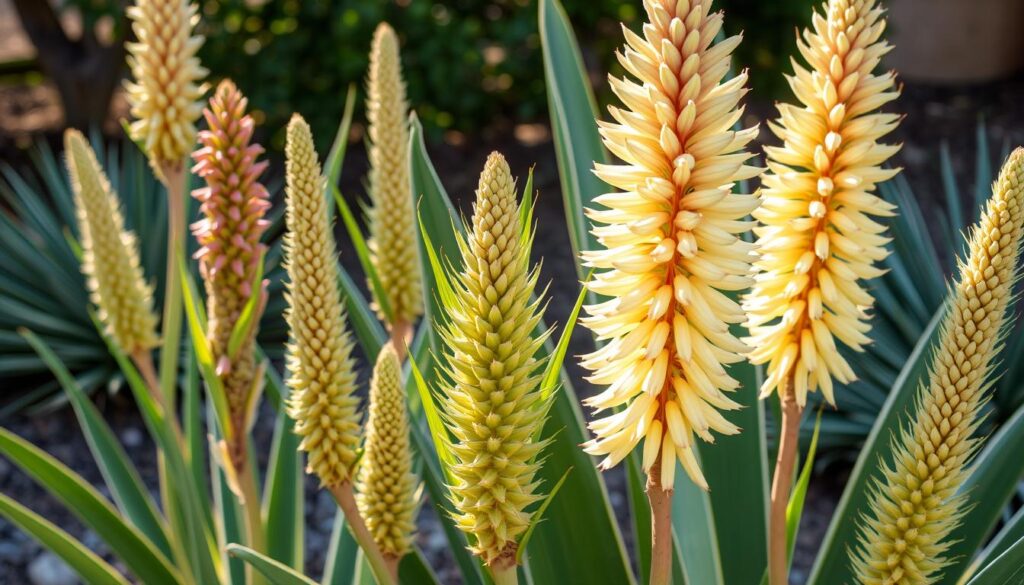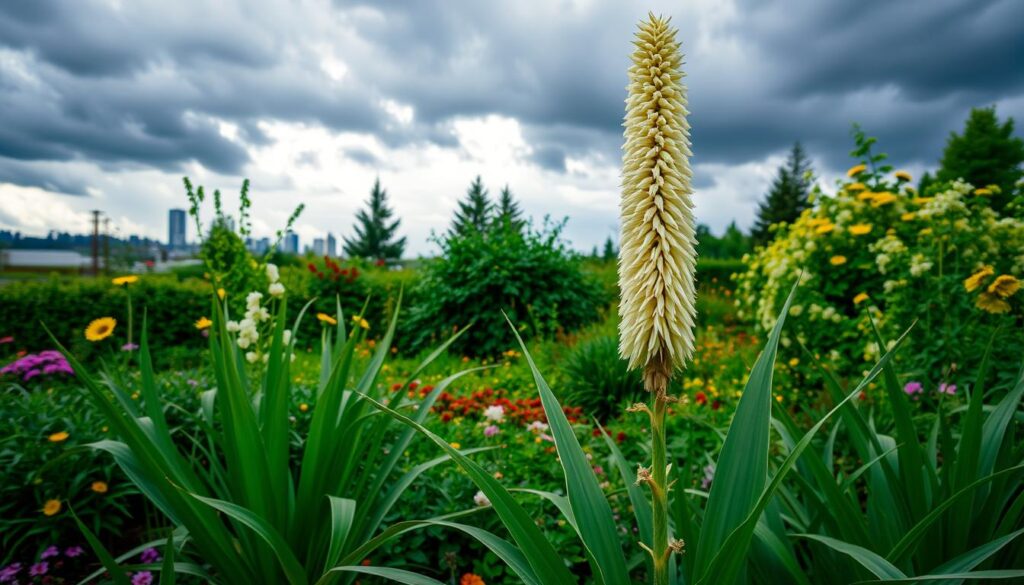Did you know Yucca gloriosa, a plant from the southeastern US, does well in Seattle gardens? This fact shows how desert plants can adapt to different climates. I’m learning about Yucca gloriosa, also called Spanish Dagger, and its toughness.
In Seattle, I’ve seen this drought-tolerant plant along East Lake Washington Boulevard. Its long leaves and tall flowers stand out in the city’s greenery. This desert plant has made a home in the Pacific Northwest’s wetter climate.
Yucca gloriosa is one of about 40 Yucca species, each with its own look. These plants handle a wide range of temperatures, living in USDA zones 4-11. Some, like Yucca rostrata, can even handle -20°F, showing how desert plants can adapt.
Key Takeaways
- Yucca gloriosa thrives in Seattle despite being native to the southeastern US
- There are about 40 recognized Yucca species with varying characteristics
- Yuccas can survive in USDA zones 4-11, showing impressive temperature tolerance
- These plants feature sword-shaped leaves and tall flowering stalks
- Yucca gloriosa can grow up to 10 feet tall with white or pale yellow flowers
- Desert plants like Yucca show remarkable adaptability to diverse climates
Introduction to Yucca Gloriosa
I’m excited to share my knowledge about Yucca gloriosa, a fascinating native desert plant. This xerophytic species is a true marvel of nature. It adapts beautifully to harsh environments. Let’s explore its habitat, classification, and common names.
Native habitat and distribution
Yucca gloriosa thrives along the southeastern coast of North America. I’ve seen it growing on sand dunes from southeastern Virginia to northern Florida. Its ability to flourish in these coastal areas shows its remarkable adaptation to challenging conditions.
Botanical classification
In the plant kingdom, Yucca gloriosa belongs to the Asparagaceae family, specifically the subfamily Agavoideae. This classification puts it among other xerophytic species known for their drought tolerance and unique adaptations.
| Family | Subfamily | Genus | Species |
|---|---|---|---|
| Asparagaceae | Agavoideae | Yucca | gloriosa |
Common names and their origins
Yucca gloriosa goes by several intriguing names. I’ve heard it called Adam’s needle, glorious yucca, and lord’s candlestick. Some folks refer to it as mound lily, Spanish bayonet, or tree lily. These names often reflect the plant’s appearance or cultural significance.
- Adam’s needle: Possibly referring to its sharp, needle-like leaves
- Glorious yucca: Highlighting its striking appearance
- Spanish bayonet: Alluding to its spiky form
- Tree lily: Describing its tree-like growth habit
Physical Characteristics of Yucca Gloriosa
Yucca gloriosa, also known as Pendulous Yucca, is a stunning plant perfect for arid landscaping. Its unique features make it stand out among other succulents and cacti.
Leaf Structure and Appearance
The leaves of Yucca gloriosa are truly remarkable. They grow in a rosette pattern, reaching lengths of 30 to 50 cm. These leaves are stiff, narrow, and dark green, with smooth edges and a sharp brown spine at the tip. Their sword-like shape adds a dramatic touch to any garden design.
Flowering Habits and Inflorescence
In late summer, Yucca gloriosa puts on a spectacular show. It produces a towering inflorescence that can reach up to 2.5 meters in height. The panicle is adorned with bell-shaped white flowers, sometimes tinged with purple or red hues. This display is breathtaking and attracts various pollinators.
Fruit Description
While fruit production is rare in the wild, when it occurs, Yucca gloriosa forms elongated berries. These leathery fruits can grow up to 8 cm long. It’s fascinating to see how this plant adapts to different environments, much like other desert plants.
| Feature | Description |
|---|---|
| Height | 6 – 10 feet |
| Width | 0 – 5 feet |
| Growth Rate | Moderate |
| Flower Season | Early Summer |
| Water Use | Moderate |
Natural History and Evolution
I’ve always been drawn to how plants survive in tough places. Yucca gloriosa is a great example of this. It shows how plants adapt to desert life.
Studies show that Yucca gloriosa came from mixing Yucca aloifolia and Yucca filamentosa. It grows in the subtropical southeast of the USA. You can find it on sandy coasts and barrier islands.
The desert is huge, covering 33.7 million square kilometers, or about a quarter of Earth. It’s home to over 500 million people and many plant species that love the dryness.
“Desert plants are nature’s true survivors, evolving ingenious ways to thrive in the harshest conditions.”
Yucca gloriosa has special ways to survive. Its leaves are thick and waxy to save water. It also has deep roots to find water underground. These features show how desert plants and their environment work together.
Yucca gloriosa is a symbol of nature’s strength. Its story of survival in the desert amazes and inspires me.
Cultivation and Care
Growing Yucca Gloriosa is surprisingly easy. It’s a great choice for those new to gardening. Its ability to conserve water makes it simple to care for.
Soil Requirements
Yucca Gloriosa does well in sandy soils that drain well. To check soil drainage, dig a hole, fill it with water, and see how long it takes to drain. If it takes over 20 seconds, add lava sand or expanded shale to improve it.
Watering Needs
This plant needs very little water, which is great for those wanting drought-resistant plants. I water mine once a month, if it’s needed. It’s perfect for gardens looking to save water.
Sun Exposure Preferences
Yucca Gloriosa loves full sun but can also handle partial shade. This makes it versatile for different garden designs.
Temperature Tolerance
This plant is incredibly hardy. It can handle temperatures as low as -4°F without damage. It even survives brief snow and freezing temperatures well.

In summary, Yucca Gloriosa fits well with desert landscaping. It’s drought-tolerant, low maintenance, and thrives in tough conditions. Adding this plant to my garden boosts its look and helps local wildlife and conservation.
Landscaping with Yucca Gloriosa
I adore using Yucca gloriosa in arid landscaping. This desert plant brings a unique look to any garden. It can grow up to 20 feet tall, making it ideal as a centerpiece or standalone plant.
In summer, Yucca gloriosa blooms with large spires of cream or white flowers. These flowers draw in bees, butterflies, and hummingbirds. It’s a beautiful way to add life to your garden without much work.
Yucca gloriosa is very versatile. I’ve used it in many places:
- Gravel and rock gardens
- Mixed perennial beds
- Containers with fast-draining soil
- Desert-themed gardens
When planning your arid garden, think about pairing Yucca gloriosa with other plants that love dry conditions. Herbs, succulents, and drought-resistant perennials go well with it. Just make sure it has good drainage and isn’t near areas where its sharp leaves could be a problem.
| Yucca Variety | Height | Special Features |
|---|---|---|
| Yucca gloriosa | Up to 20 ft | Striking silhouette, cream/white flowers |
| Yucca rigida | Up to 12 ft | Blue-green leaves, drought-tolerant |
| Yucca aloifolia | Varies | Fast-growing, container-friendly |
Adding Yucca gloriosa to your garden design makes for a beautiful, easy-care space that does well in dry areas. It’s an excellent choice for those wanting to use desert plants in their gardens.
Propagation Methods
I love growing Yucca gloriosa, a stunning native desert plant that’s easy to propagate. It’s a xerophytic species, meaning it thrives in harsh conditions. This makes it simple to grow more plants. Let’s look at how to multiply this beauty.
Seed Propagation
Starting Yucca gloriosa from seeds is budget-friendly but takes time. I sow seeds in well-draining soil at 70-80°F for best results. It’s a slow process, but seeing those tiny seedlings grow is rewarding.
Root and Shoot Cuttings
For faster results, I take cuttings in spring or summer. Root cuttings work well, but stem cuttings are my favorite. I let them callus for a few days before planting in a sandy mix. With proper care, they root in weeks.
Division Techniques
Dividing mature Yucca gloriosa plants is my go-to method. It’s quick and gives instant results. I carefully separate offshoots or plantlets from the mother plant, ensuring each has roots attached. This technique works great for many xerophytic species.
| Propagation Method | Success Rate | Time to Maturity |
|---|---|---|
| Seed Propagation | 60-70% | 2-3 years |
| Cuttings | 80-90% | 1-2 years |
| Division | 95-100% | 6 months – 1 year |
Propagating Yucca gloriosa is a fun way to expand your garden. Whether you choose seeds, cuttings, or division, you’ll soon have more of these stunning plants to enjoy or share with friends.
Desert Plants: Yucca Gloriosa’s Adaptive Features
Yucca gloriosa is a top example of a plant that can survive without much water. I find it amazing how it can live in the desert. Its ways of saving water make it a strong plant in dry places.
Water Conservation Strategies
The Yucca gloriosa has thick, waxy leaves that help it save water. These leaves act like barriers, keeping moisture inside during dry times. It’s incredible how nature helps plants survive in harsh conditions.
Heat Tolerance Mechanisms
Yucca gloriosa can take the heat like no other. Its special design lets it handle high temperatures that would kill other plants. This ability to endure heat is key to its survival in the desert.
Comparison with Other Xerophytic Species
When I look at Yucca gloriosa and its relatives like Yucca aloifolia and Yucca filamentosa, I notice they’re all good at saving water. Let’s see how these desert plants compare:
| Species | Max Height | Leaf Type | Flower Color | Blooming Season |
|---|---|---|---|---|
| Yucca gloriosa | 10 feet | Sword-like, thick | White/pale yellow | Late spring/summer |
| Yucca aloifolia | 20 feet | Dagger-like, sharp | White/cream | Summer |
| Yucca filamentosa | 8 feet | Sword-like, fibrous | White | Early summer |
Each of these plants has its own way of saving water and surviving in tough places. Their different traits make them great for gardens that need to save water.
Varieties and Cultivars
I’ve learned that Yucca gloriosa, like many succulents and arid plants, comes in many varieties. These plants have adapted to tough conditions, making them great for xeriscaping. Let’s look at some interesting cultivars of this desert beauty.
The ‘Variegata’ variety is known for its striking leaves. They have cream-colored stripes along the edges, adding elegance to any garden. For those who want something smaller, the ‘Bright Star’ cultivar is a good choice. It has vibrant foliage but is more compact.

Yucca gloriosa var. minor is great for small spaces. It has a smaller size, perfect for tight spots. The var. obliqua has leaves that twist, creating an interesting look. For those who like subtle differences, the f. acuminata variety has leaves that taper to a fine point.
The f. pruinosa variety is quite interesting. Its leaves have a waxy coating that makes them look bluish and helps them resist drought. The var. plicata has folded leaves, giving it a unique look.
| Cultivar | Key Feature | Best Use |
|---|---|---|
| Variegata | Cream-striped leaves | Accent plant |
| Bright Star | Compact size | Container gardening |
| var. minor | Small stature | Rock gardens |
| f. pruinosa | Bluish waxy leaves | Drought-resistant landscaping |
These Yucca gloriosa varieties are great for different landscapes, from containers to xeriscapes. They can thrive in dry conditions, making them perfect with cacti and other succulents in desert gardens.
Ecological Significance
I’ve always been fascinated by the role of native desert plants in their ecosystems. Yucca gloriosa, like many desert dwellers, plays a crucial part in coastal dune habitats. It helps stabilize shifting sands and provides shelter for various wildlife species.
Role in Native Ecosystems
In its natural habitat, Yucca gloriosa is key to desert ecology. These plants have adapted to thrive in harsh conditions. Did you know deserts cover about one-third of Earth’s dry land? Yucca gloriosa and other desert plants are vital for carbon sequestration, helping combat global warming.
Interactions with Wildlife
Yucca gloriosa isn’t just a pretty face in the desert landscape. It’s a lifeline for many creatures. The plant’s flowers attract pollinators, and its structure offers refuge for small animals. Birds often use its sturdy leaves as nesting material. It’s a perfect example of how desert plants support biodiversity in seemingly barren environments.
Potential Invasive Concerns
While Yucca gloriosa is beneficial in its native range, it’s important to note its potential as an invasive species. It has naturalized in several countries outside its original habitat, including Italy and parts of South America. As with any introduced species, we need to monitor its spread carefully to prevent disruption of local ecosystems.
FAQ
What is Yucca gloriosa?
Where is Yucca gloriosa native to?
What are the physical characteristics of Yucca gloriosa?
How did Yucca gloriosa evolve?
What are the cultivation and care requirements for Yucca gloriosa?
How is Yucca gloriosa propagated?
What desert adaptations does Yucca gloriosa exhibit?
Are there any varieties or cultivars of Yucca gloriosa?
What is the ecological significance of Yucca gloriosa?
Source Links
- Types of Yucca Plants – Yuccas Care & Growing Guide| Planet Desert
- THE DESERT NORTHWEST – Plant Galleries
- The Yucca Page
- Types of Yucca Plants – Yuccas Care & Growing Guide| Planet Desert
- Yucca: plant profile, care & propagation – Plantura
- Find Trees & Learn | University of Arizona Campus Arboretum
- Yucca gloriosa Spanish Dagger, moundlily yucca, Palm Lily, Roman Candle, Mound Lily Yucca, Spanish Dagger PFAF Plant Database
- Global Deserts Outlook – Chapter 1.pd
- Convergent Evolution of Desert Plants from Africa and the Americas
- Evolutionary Adaptations of Desert Plants
- Desert Plants for Landscaping Garden Design- with Ideas, Pics, and more… | Planet Desert
- Planting Desert Specimen Plants
- Selecting Vegetable Crops for Small-Scale Desert Production | Extension | University of Nevada, Reno
- Tips for Landscaping with Yucca Plants | Gardener’s Path
- Yuccas for landscaping – Guzman’s Garden Centers
- The basics of propagating plants in the Tucson desert
- How to Propagate Cacti & Succulents – Desert Plants Of Avalon
- Types of Yucca Plants – Yuccas Care & Growing Guide| Planet Desert
- Yucca
- Yuccas – Evergreen Arborist Consultants | Certified Tree Arborist
- 127 Stunning Desert Plants – FTD.com
- 50 Desert Plants – 10 Most Common + 40 Others with Pics & Facts
- Best Cold Hardy Plants for our Desert
- Plant Ecology of the Sonoran Desert Region
- Importance Of Maintaining Our Deserts – Lonestar Investment
- Environmental Science


